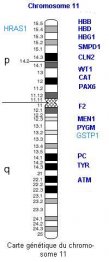The ATM gene is located on chromosome 11.
It is a recessive gene.
ATM is one of the most complex genes.
In Ataxia telangiectasia, mutations are different from one patient to another.
ATM
 The chromosome is the only ordered form of the DNA molecule. So scientists have used it to create a scale of localization of genes: each chromosome arm is divided arbitrarily into equal parts and subparts numbered from the centromere to the outside.
The chromosome is the only ordered form of the DNA molecule. So scientists have used it to create a scale of localization of genes: each chromosome arm is divided arbitrarily into equal parts and subparts numbered from the centromere to the outside. Thus, the ATM gene, functional or not, is located in 11q22.3, ie:
- On the long arm (q) of the 11th chromosome (an autosome)
- On the 22nd section of the arm
- On the third sub-portion of this section (see diagram).
Beside, it has been established in AT patients that no mutation was identical. Some mutations allow the production of a protein altered ATM, but not the majority.
Recessive
Like all genes, the ATM gene is present in two copies (one on chromosome 11 from the mother and the other one from the father). Each copy is named "allele".
In the case of alteration of one allele, the other is capable of producing the ATM protein, which explains that parents and siblings of AT patients don't have the symptoms of ataxia telangiectasia. However, scientists suspect that this lack can cause a number of other conditions.
The gene is so called "recessive" , as opposed to "dominant": to be suffering from AT, man must have a mutation on each of the two alleles that are inherited. AT is also referred to as an autosomal recessive disease: the chromosome 11 is not the chromosome determining the gender, so the transmission of the disease is not related to the gender.
Unfortunately, as we have seen, mutations (changes) of the ATM gene on each allele of an individual are different and they differ from one individual to another: it makes it even more difficult to develop genetic treatments.
In the case of alteration of one allele, the other is capable of producing the ATM protein, which explains that parents and siblings of AT patients don't have the symptoms of ataxia telangiectasia. However, scientists suspect that this lack can cause a number of other conditions.
The gene is so called "recessive" , as opposed to "dominant": to be suffering from AT, man must have a mutation on each of the two alleles that are inherited. AT is also referred to as an autosomal recessive disease: the chromosome 11 is not the chromosome determining the gender, so the transmission of the disease is not related to the gender.
Unfortunately, as we have seen, mutations (changes) of the ATM gene on each allele of an individual are different and they differ from one individual to another: it makes it even more difficult to develop genetic treatments.